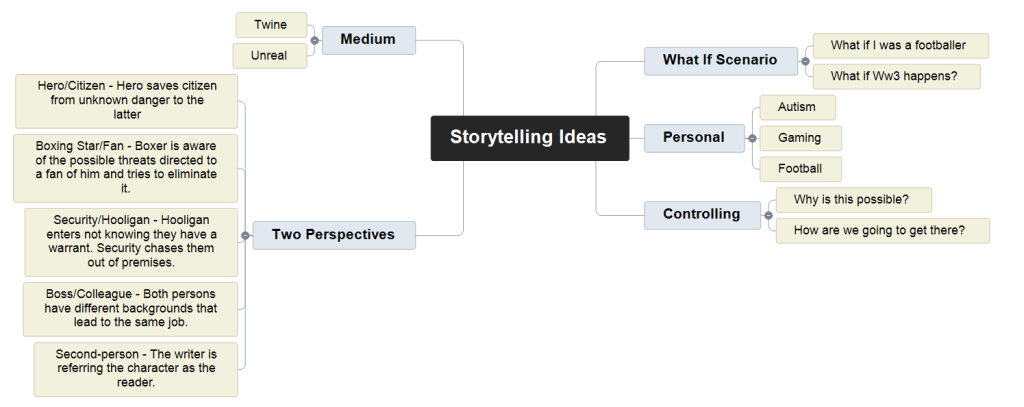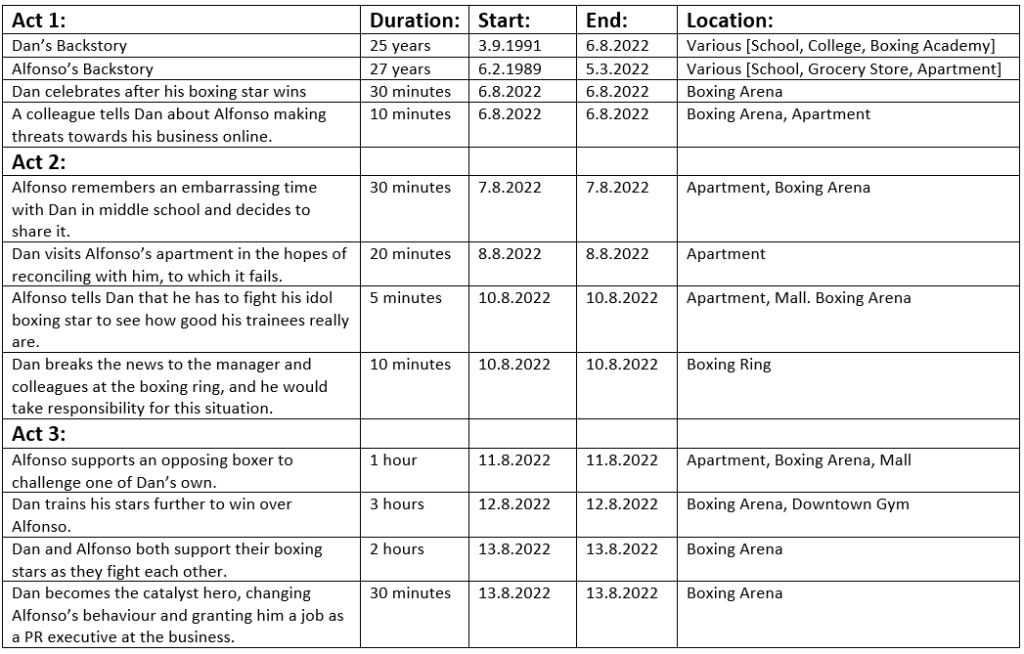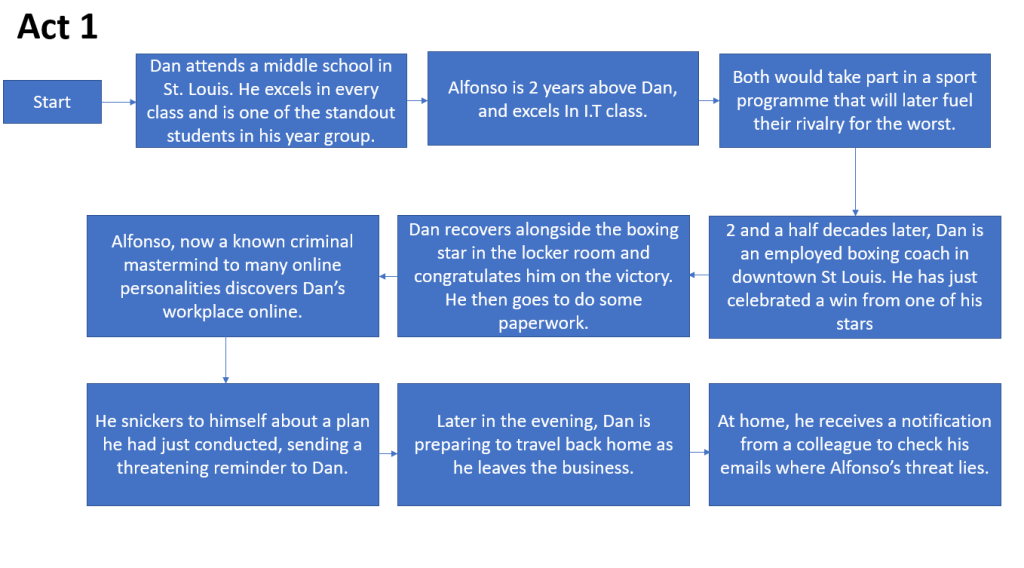Ideas Generation
We were required to write a compelling story using one of many mediums for the module assignments. I have written down many different ideas on a mind map to showcase the brainstorming process from which I will be taking ideas from to tell a story.

Upon further discussion with the lecturer about these potential ideas, I have developed more ideas towards the Two Perspectives style of narrative writing purely because it is intriguing to see two completely different personalities cross paths after taking vastly contrasting routes. It’s also a great way to make the story feel suspenseful (MasterClass, 2021), as the “secondary character doesn’t know the information, so narrating from their point of view allows you to withhold the information from the reader in a plausible way.”
The software I will be using to tell this story is Twine purely due to it being efficient to tell a story of this calibre while also adding additional elements that make storytelling immersive, like different branches to take and the visual imagery that will accompany the story such as a boxing arena, an apartment complex where the antagonist would live and a school where the characters attended before branching off into their own adventures.
Character Planning
There was a character questionnaire on Canvas about how our characters would respond to the questions provided to understand more about them. When thinking about the flaws that my character would be having, there was a good list posted by Ackerman (2016) listing all of the available character flaws to enhance the types of characters that would normally make them one-dimensional. Two of the flaws were flaky and stubborn, which I’ve used as the biggest flaws of my character.

I have put together a mind map of my character’s answers to these questions. I have also created a second character that has a second perspective, ensuring I make that character’s personality drastically different from the first.

My main inspiration for Dan derives from Doc Louis from the Punch Out!! games (1984-2009) and Tony “Duke” Evers from Rocky IV (1985). Towards the end of the story, Dan becomes the catalyst hero to Alfonso (the bad guy). He takes inspiration from Twilight Sparkle (Hasbro, 2010; Hasbro Studios, 2013) who reforms villains to be an ally rather than an enemy.

Alfonso is primarily the antagonist of the story, as he is known to be a criminal mastermind behind a computer . The inspirations for Alfonso come from the minds of Paul Le Roux (The Infographics Show, 2019). Even though he is evil behind a screen, he is caring to his dog and protects it no matter how threatening other people are towards his dog. Even though his activity is famous in the local area, he is afraid of getting caught in a physical environment.
Setting
When we look at McKee’s four dimensional rule for story settings (1997:p68-78), we can find what location, period and duration of the story will take place in. He also explains the level of conflict, which is the primary human element and logical ruleset of my story.
The story takes place in St. Louis in the present day. The specific building is a boxing arena where Dan works. The arena is inspired by the Punch Out!!! Games (1984 – 2009). Both main characters have a backstory that spans many different places located within St. Louis.
Theme
When thinking about the overall story theme, or character themes, I had a hard time thinking about what theme is appropriate for the story I am writing. Luckily, there’s something to help me get some ideas.

Alfonso’s backstory is themed around individual vs society, as he is the only one who is aware of his online criminality. The overall individual themes of both Dan and Alfonso fall within courage and fear respectively, as Dan is brave to keep training his boxing stars and putting himself in an environment where he can be seriously harmed or hurt, while Alfonso is not only afraid of being caught due to his online identity, but evokes fear in other people due to his behaviour online.
Structure
McKee (1997:p37-42) notes the key points to create a good story. The story beat “is the smallest element of structure” that a scene is built around, which then becomes a sequence which in itself becomes a few scenes ranging from the setup to the eventual climax in waves of acts which “builds the largest structure of all: the story.” The last act could build into a “story climax which brings about absolute and irreversible change.”
Another example is the way the story is structured into five parts. Todorov and Weinstein (1969:75) explains the cycle of narrative, starting with a “state of equilibrium” that is disrupted by a problem. A new equilibrium would be put in place upon recognition and repair of the disruption. The journal has also listed examples of media that have this cycle of narration.
The type of story I will be going for has a mix of the Nestpool and Converging Ideas structures, as it’s told from two perspectives that will come together in the end. The type of structure I will be adopting would be the Three Act Structure, adapted from Into the Woods: A Five Act Structure Into Story (Yorke, 2014). In the book, Yorke explains the Three Act Structure and how each climax of an individual act is a turning point within a story. “It’s a model that lies behind all modern mainstream film and TV narratives.” reedsyblog (2018) also splits each act into three critical components to ensure the effectiveness of each story using this structure.

Another way to look at how the story will be split into acts is to think about how the story will be structured using Dan Harman’s story Circle (Adult Swim, 2020).

In the case of my story, the two characters would start out at the first point, which is themselves and who they represent. They then need to become what they are now in the present day, go on to fulfil that dream. Alfonso would then search for Dan’s workplace online, which would be a turning point within the story and ultimately kicks off the second act.
Dan would find out about the threats Alfonso is making toward the business and try to reconcile with him through word of mouth, as he has known him from middle school. Alfonso would then threaten to make a humiliating moment for Dan public if he didn’t reply to the email. Alfonso takes and supports a well known idol boxing star to challenge one of Dan’s boxers to show how truly powerful and skilled Dan’s boxing stars truly are, which Dan obliges.
Dan decides to accept Alfonso’s challenge, who now shows up in person to witness the match. By training his stars to the limit, Dan wins the boxing match. The final point will see Dan evoke a change in Alfonso, offering him a job vacancy at his workplace as a PR executive with the condition that Alfonso would leave his criminal history behind him. Alfonso would accept this and become the new PR executive.
So when we put all of those points together, we should get an overview that is something like this. The synopsis and story itself takes inspiration from a few elements from Space Jam (1996), primarily involving the Nerdlucks and how they end up changing sides at the end of the movie after losing a basketball game.

I’ve also created a Gantt Chart of the entire story and split it into the three acts. The end of each act will signify a turning point within the story showing how the characters will react to the situation they are faced with.

To finish things off, I have quickly put together a flowchart of the narrative as well. It contains the same story, but I included some additional material that I have developed further to drive the story forward. I split them into different acts to give you an understanding of what’s going to be included in each segment.



References:
Ackerman, A. (2016) How Character Attributes and Flaws Work Within Character Arc. [Blog Post] Writers Helping Writers. 24 November. Available online: https://writershelpingwriters.net/2016/11/how-character-attributes-and-flaws-work-within-character-arc/ [Accessed 12th October 2022]
Adult Swim (2020) Dan Harmon’s Story Circle | Rick and Morty | adult swim [Video] Available online: https://www.youtube.com/watch?v=RG4WcRAgm7Y [Accessed 2nd November 2022]
MasterClass (2021) How to Write Multiple Perspectives: 5 Tips for Switching Points of View [Blog Post]. MasterClass. 19 August. Available online: https://www.masterclass.com/articles/how-to-write-multiple-perspectives [Accessed 26th October 2022]
McKee, R. (1997) Substance, Structure, Style, and the Principles of Screenwriting. New York. HarperCollins.
My Little Pony: Equestria Girls (2013) Directed by Jayson Thiessen. Hasbro Studios.
My Little Pony: Friendship is Magic (2010 – 2019) Developed by Lauren Faust. [TV Programme]. Hasbro.
NOW NOVEL CC (2022) How to choose good themes for stories: 5 tips. Available online: https://www.nownovel.com/blog/choosing-themes-for-stories/ [Accessed 26th October 2022]
Punch Out!! Series (1984 – 2009) [Video Game Franchise] Nintendo.
Reedsy Ltd. (2018) Story Structure: 7 Narrative Structures All Writers Should Know [Blog Post] reedsyblog. 20 July. Available online: https://blog.reedsy.com/guide/story-structure/ [Accessed 2nd November 2022]
Rocky IV (1985) Directed by Sylvester Stallone. Metro-Goldwyn-Mayer.
Space Jam (1996) Directed by Joe Pytka. Warner Bros.
The Infographics Show (2019) The Coder Who Became A Criminal Mastermind – Paul Le Roux [Video] Available online: https://www.youtube.com/watch?v=6f8ReRRmFYs [Accessed 19th October 2022]
Todorov, T & Weinstein, A. (1969) Structural Analysis of Narrative. NOVEL: A Forum of Fiction. Duke University Press. (Vol.3, No.1, Autumn) 70-76.
Yorke, J. (2014) Into the Woods: A Five Act Structure Into Story. UK. Penguin.